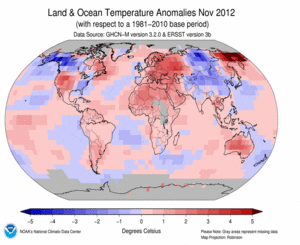 On Monday, scientists from the National Oceanic and Atmospheric Administration (NOAA) said that for the 333rd consecutive month November 2012 brought higher than average global temperatures. In fact, the last time November temperatures dropped below the 20th century average was in 1976. Last month global average temperature over land and oceans was 56.41°F, or the 5th highest recorded average land/sea temperatures during any November since 1880, 1.21°F warmer than the global 20th century average. The last time any month dipped below the long-term average was February 1995, 28 years ago.
On Monday, scientists from the National Oceanic and Atmospheric Administration (NOAA) said that for the 333rd consecutive month November 2012 brought higher than average global temperatures. In fact, the last time November temperatures dropped below the 20th century average was in 1976. Last month global average temperature over land and oceans was 56.41°F, or the 5th highest recorded average land/sea temperatures during any November since 1880, 1.21°F warmer than the global 20th century average. The last time any month dipped below the long-term average was February 1995, 28 years ago.
The above average November temperatures in the contiguous United States brings the nation close to setting the record for the hottest year since record-keeping began in 1880. Average temperatures in the lower 48 states was 44.1°F, 2.1° above the 20th century average. While above-average, November 2012 ranks as just the 20th warmest November on record in the lower 48 but still enough to keep the year on track as the hottest on record in the US. The period from January through November 2012 is the warmest on record for the United States.
Average global sea surface temperatures
Most of the world’s ocean surface temperatures were above average with record warmth observed in eastern areas of the North Atlantic Ocean and many Arctic Seas regions. Conversely, the ongoing negative phase of the Pacific Decadal Oscillation kept the northeastern Pacific Ocean cooler than average. Globally, average sea surface temperatures was 0.90°F above the 20th century average, making the November the sixth warmest on record.
Arctic sea ice extent
The arctic sea ice extent throughout November was the third smallest in the satellite record. Sea ice extent for November was 3.83 million square miles or 533,000 square miles below average. The linear rate of decline for November sea ice extent through 2012 is -4.8 percent per decade as compared with the 1979-2000 average. In total the Arctic experienced ice loss roughly equivalent in size to the United States.



